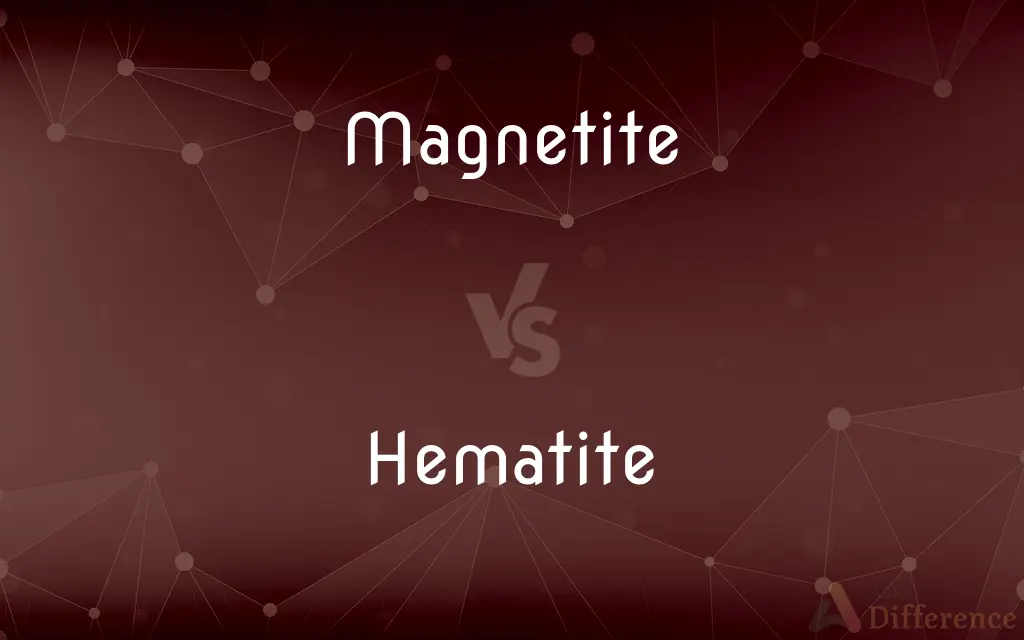Magnetite vs. Hematite — What's the Difference?
By Tayyaba Rehman — Updated on September 20, 2023
Magnetite is an iron oxide with the formula Fe3O4 and is naturally magnetic. Hematite is another iron oxide with the formula Fe2O3 but is not naturally magnetic.

Difference Between Magnetite and Hematite
Table of Contents
ADVERTISEMENT
Key Differences
Magnetite, with the chemical formula Fe3O4, is one of the primary iron ores and is known for its strong magnetism. Hematite, on the other hand, has the formula Fe2O3 and is also a significant source of iron but lacks natural magnetism. Both are iron oxides, but they differ in their chemical composition, which results in different properties.
Magnetite's natural magnetic property makes it useful in various applications beyond just iron extraction. It's often used in magnetic separation processes and electrical applications. Hematite, despite its lack of magnetism, is prized for its abundance and high iron content, often finding use in pigment, radiation shielding, and even jewelry.
In terms of appearance, Magnetite usually occurs in a metallic-black form, whereas Hematite is often found in a metallic to rusty red. They both serve as valuable sources of iron, but their different physical and chemical properties determine how they are processed and for what purposes. For example, Hematite is often easier to process for iron extraction because it usually contains fewer impurities compared to Magnetite.
Both Magnetite and Hematite play essential roles in various scientific and industrial processes. Magnetite can be synthetically prepared for specific applications, while Hematite is often preferred for certain types of steel production. Their significance extends beyond just serving as iron ore; they are versatile materials with various applications based on their unique properties.
Comparison Chart
Chemical Formula
Fe3O4
Fe2O3
ADVERTISEMENT
Magnetism
Naturally magnetic
Not magnetic
Color
Metallic-black
Metallic to rusty red
Primary Uses
Iron extraction, magnetic separation, electrical applications
Iron extraction, pigment, radiation shielding
Abundance
Less common
More common
Compare with Definitions
Magnetite
A material commonly used in magnetic separation processes.
The magnetite helped in the magnetic separation of particles.
Hematite
A red or black mineral with the formula Fe2O3 used primarily as an iron ore.
Hematite is rich in iron and is a key component in steel manufacturing.
Magnetite
A mineral often found in igneous and metamorphic rocks.
Scientists discovered magnetite in a volcanic region.
Hematite
A mineral that can form in a variety of crystal structures.
The hematite specimen had a unique crystal structure.
Magnetite
A crystal that forms in octahedral or dodecahedral shapes.
The magnetite crystal in the exhibit was an octahedron.
Hematite
A common mineral found in sedimentary, metamorphic, and igneous rocks.
Hematite layers were identified in the sedimentary rock strata.
Magnetite
A naturally magnetic iron oxide with the formula Fe3O4.
The magnet stuck to the piece of magnetite.
Hematite
A mineral often used for pigments and radiation shielding.
Hematite's reddish pigment is used in some paints.
Magnetite
A black or brownish-black mineral that is one of the main iron ores.
Magnetite is commonly used for the production of iron and steel.
Hematite
A non-magnetic iron oxide commonly used in jewelry.
The hematite necklace had a beautiful metallic luster.
Magnetite
Magnetite is a mineral and one of the main iron ores, with the chemical formula Fe3O4. It is one of the oxides of iron, and is ferrimagnetic; it is attracted to a magnet and can be magnetized to become a permanent magnet itself.
Hematite
Hematite (), also spelled as haematite, is a common iron oxide compound with the formula, Fe2O3 and is widely found in rocks and soils. Hematite crystals belong to the rhombohedral lattice system which is designated the alpha polymorph of Fe2O3.
Magnetite
The mineral form of black iron oxide, Fe3O4, that often occurs with magnesium, zinc, and manganese and is an important ore of iron.
Hematite
A black or blackish-red to brick-red mineral, essentially Fe2O3, the chief ore of iron.
Magnetite
(mineral) A magnetic mineral, Fe3O4, one of the primary ores of iron. It has also been called lodestone.
Hematite
(mineral) An iron ore, mainly peroxide of iron, Fe2O3.
Magnetite
An oxide of iron (Fe3O4) occurring in isometric crystals, also massive, of a black color and metallic luster. It is readily attracted by a magnet and sometimes possesses polarity, being then called loadstone. It is an important iron ore. Called also magnetic iron.
Hematite
An important ore of iron, the sesquioxide, so called because of the red color of the powder. It occurs in splendent rhombohedral crystals, and in massive and earthy forms; - the last called red ocher. Called also specular iron, oligist iron, rhombohedral iron ore, and bloodstone. See Brown hematite, under Brown.
Magnetite
An oxide of iron that is strongly attracted by magnets
Hematite
The principal form of iron ore; consists of ferric oxide in crystalline form; occurs in a red earthy form
Common Curiosities
What is Hematite?
Hematite is a non-magnetic iron oxide with the formula Fe2O3.
How does Magnetite differ from Hematite in chemical formula?
Magnetite has the formula Fe3O4, while Hematite has the formula Fe2O3.
Is Hematite magnetic?
No, Hematite is not naturally magnetic.
What are the primary uses of Hematite?
Hematite is mainly used for iron extraction, pigments, and radiation shielding.
What is Magnetite?
Magnetite is a naturally magnetic iron oxide with the formula Fe3O4.
What color is Hematite?
Hematite can be metallic to rusty red.
Where is Magnetite commonly found?
Magnetite is often found in igneous and metamorphic rocks.
Where is Hematite commonly found?
Hematite is commonly found in sedimentary, metamorphic, and igneous rocks.
Can Magnetite be used in jewelry?
While less common, Magnetite can be used in magnetic jewelry.
Is Hematite used in jewelry?
Yes, Hematite is often used in jewelry for its metallic luster.
Is Magnetite abundant?
Magnetite is less common compared to Hematite.
Is Magnetite magnetic?
Yes, Magnetite is naturally magnetic.
What color is Magnetite?
Magnetite is usually metallic-black.
What are the primary uses of Magnetite?
Magnetite is primarily used for iron extraction, magnetic separation, and electrical applications.
Is Hematite abundant?
Yes, Hematite is more common and is a primary source of iron.
Share Your Discovery

Previous Comparison
Intransigence vs. Intransigent
Next Comparison
Said vs. SaysAuthor Spotlight
Written by
Tayyaba RehmanTayyaba Rehman is a distinguished writer, currently serving as a primary contributor to askdifference.com. As a researcher in semantics and etymology, Tayyaba's passion for the complexity of languages and their distinctions has found a perfect home on the platform. Tayyaba delves into the intricacies of language, distinguishing between commonly confused words and phrases, thereby providing clarity for readers worldwide.















































